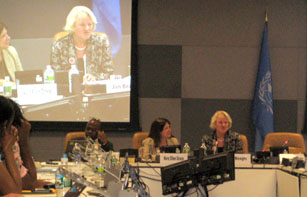
Jan Beagle, UNAIDS Deputy Executive Director, Management and External Relations
Credit: UNAIDS
Although there is growing international attention for the rights of people with disabilities, governments and policymakers rarely consider disability issues when formulating their HIV strategic plans.
To highlight the significance of this area of work and advocate for national integration of the needs of persons with disabilities into all aspects of the AIDS response, a partner’s forum on AIDS and Disability was held on 9 June during the High Level Meeting on AIDS.
The event was co-chaired by Jan Beagle, UNAIDS Deputy Executive Director, Management and External Relations and Professor Nora Ellen Groce, Director, Leonard Cheshire Disability & Inclusive Development Centre at University College London.
“Both the AIDS movement and the disability movement have at their core a respect for human rights of the individual. Both are movements which are confronting sigma and discrimination of different kinds. Both HIV and disability affect not only the individual but also the household, in ways that you all know so well. Where you have both HIV and disability, there's a double stigma, and a double burden,” said Jan Beagle, UNAIDS Deputy Executive Director, Management and External Relations, introducing the event.
Mary Muthoni Rop is a mother of three children who lives in rural Kenya. She has multiple disabilities and is living with HIV. She has become an activist with Thika Disabled Fighting HIV and AIDS and spoke at the event of the myriad difficulties and vulnerability the HIV epidemic has brought to people living with a disability which include obstacles to access to HIV services due to distances and infrastructure of health facilities. “We find that most of the health facilities are not accessible to people with disability: for example a hospital having stairs all over,” she said. HIV prevention information is also often inaccessible. “We find that in most of our health facilities, we don't have people who can give proper information to people with disability. We don't have workers trained in sign language interpretation.”
We've all got to work together: governments in North and South, civil society and in particular, people living with disabilities and people living with HIV
Jan Beagle, UNAIDS Deputy Executive Director, Management and External Relations
In 2006 the United Nations Convention on the Rights of Persons with Disabilities was adopted in 2006 and ratified in 2008. This Convention obliges states to provide access to sexual and reproductive health including HIV information and services for all persons with disabilities. The UN Development Group under the leadership of the UNDP Administrator has developed specific guidance for UN country teams on integrating disability into all its work and that of the UN system at global and regional levels.
Stephen Lewis, co-founder and co-director of AIDS-Free World spoke about the need for national government to transform this global instrument into a tool, saying “countries need to understand that they need to take the Convention and turn international law into national law in order for it to be effective and implemented.”
Disabled people’s organizations in different countries in Africa and Asia are becoming more and more involved in the HIV arena to mainstream disability into HIV programmes. Richard Kabeto Matlhare head of Botswana’s National AIDS Coordinating Agency shared insights from his country’s response.
Etienne Krug, Director of Violence and Injury Prevention and Disability gave an overview of the global report which was launched by the World Health Organization earlier in the day “and the big message of the report is that we cannot continue to ignore the needs of 1 billion people in the world.”
“What the report clearly states is that disability results from impairment, but much more from the barriers that society erects. Barriers such as stigma and discrimination, lack of adequate health care and rehabilitation services, inaccessible transport, buildings, information, communication technologies." said Dr Krug
What’s needed is “attacking those barriers, which contribute to a large number of negative outcomes: poorer health status, poorer employment status, less access to education,” he added.
Summing up the discussion as co-chair, Jan Beagle stressed the actions needed to ensure the needs of persons with disabilities are included into all aspects of the AIDS response. “We know that there's very far to go. However, we know how to do it, and the way to do it is by working together. We've all got to work together: governments in North and South, civil society and in particular, people living with disabilities and people living with HIV.”
The AIDS and Disability Partners Forum was organized by UNAIDS in collaboration with Global Partnership for Disability and Development, Health Canada, USAID, US State Department, ILO, UNDESA, UNICEF and WHO.
UN General Assembly High Level Meeting on AIDS
Thirty years into the AIDS epidemic, and 10 years since the landmark UN General Assembly Special Session on HIV/AIDS, the world has come together to review progress and chart the future course of the global AIDS response at the 2011 UN General Assembly High Level Meeting on AIDS from 8–10 June 2011 in New York. Member States are expected to adopt a new Declaration that will reaffirm current commitments and commit to actions to guide and sustain the global AIDS response.




